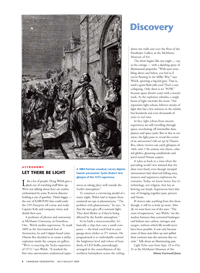Let there be light
Originally published in June 2009 in Canadian Geographic
Like a lot of people, Doug Welch gets a kick out of watching stuff blow up. We’re not talking about fiery crashes orchestrated by some B movie director holding a can of gasoline. Think bigger — the sort of KABOOM that could jostle the USS Enterprise off course and make Captain Kirk and company wince and shield their eyes.
A professor of physics and astronomy at McMaster University in Hamilton, Ont., Welch studies supernovas. To mark 2009 as the International Year of Astronomy, he and Calgary-based artist Dianne Bos decided to recreate a stellar explosion inside the campus art gallery. “We’re re-enacting the Tycho Supernova of 1572,” says Welch. “It marked the first time astronomers understood supernovas as taking place well outside the earth’s atmosphere.”
To construct a convincing model of a starry night, Welch had to bypass those outdated set-ups at planetariums. “The problem with planetariums,” he says, “is that the stars give off a constant light. They don’t flicker as if they’re being affected by the earth’s atmosphere.”
So he built a microcontroller. It’s basically a chip that runs a small computer— the kind you’d find in your garage door clicker or TV remote. He programmed it to individually control the brightness levels and colour of hundreds of LED bulbs painstakingly arranged in the constellations of the Northern Hemisphere across the ceiling, down the walls, and over the floor of the Panabaker Gallery at the McMaster Museum of Art.
The show begins like any night—say, at the cottage—with a dazzling spray of illuminated pinpricks. “With stars twinkling above and below, viewers will think they’re floating in the Milky Way,“ says Welch, sporting a big kid grin. That is, until a giant flash jolts you! That’s a star collapsing. Only, there is no “POW” because space doesn’t come with a soundtrack. As the explosion subsides, a single beam of light encircles the room. This represents light echoes, left-over streaks of light that last a few minutes in the exhibit, but hundreds and even thousands of years in real time.
In fact, light echoes from ancient supernovas are still traveling through space, ricocheting off interstellar dust, planets and space junk. But in this re-creation, the light pans to reveal the corner of an astronomer’s lab set up by Dianne Bos, where viewers can catch glimpses of 16th- and 17th-century star charts, celestial globes, gleaming candlesticks and jewel-toned Persian carpets.
It takes us back to a time when the prevailing worldview insisted that the skies were fixed, even though intrepid astronomers had observed falling stars, meteors and supernova explosions for centuries. Today, we know better, “but we’re still inward,” says Welch, only it’s technology (hand-held devices) and not religion that has us bowing our heads in silence. Supernovas have this way of bringing together past, present and future.
If viewers take anything from this show, though, it would be to look up more. After all, we were born out of the stars. “The cores of supernovas,” says Welch, “are the nuclear furnaces that converted hydrogen and helium into carbon, nitrogen and oxygen, without which life would never have been possible. It was only because some of these stars blew up and spilled their contents back out into the universe that we exist.” Talk about an illuminating past.
Light Echo runs from September 10 to October 31 at the McMaster Museum of Art.







